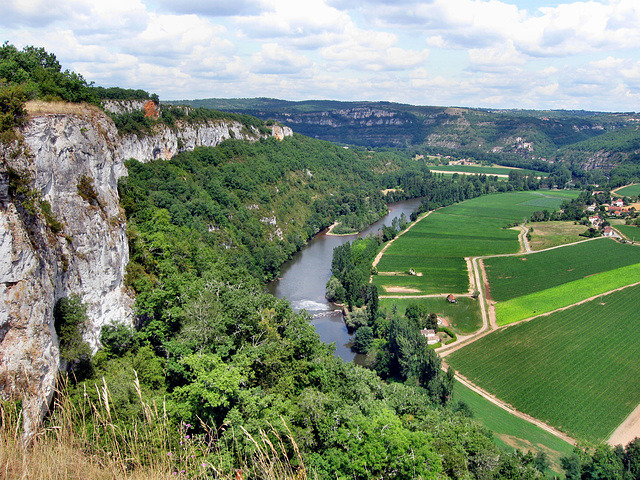
Occitanie
Souillac - Sainte-Marie
Souillac is a town, that I cannot pass, without stopping and visiting the former abbey church. Legends tell, that the abbey was founded by Saint Eligius (Saint Eloi), advisor of Merovingian King Dagobert I. The abbey got destroyed by the Saracens, and Charlemagne commissioned the reconstruction, which again was ruined got by Norman invaders. Of course, it got looted during the Wars of Religions but existed up to the French Revolution.
The abbey church, today serving the parish, got built on the blueprint of a Latin Cross in the 12th century. The single nave is about 15 ms wide. Above are no vaults, but three domes.
Inside this fantastic church are two Romanesque works of art, that are breathtaking.
But - the church was locked.
Saint-Martin-de-Vers - Saint-Martin-de-Vers
Saint-Martin-de-Vers is a small village with a fortified church at its center. The church dates from the 15th century. I found that idyll inside the church.
The valley of the Cele
........From Figeac there are two trails to Cahors. One follows the river Lot and the other one the river Cele....
Cahors - Pont Valentré
Cahors is situated within a U-shaped bend in the River Lot. There was a celtic settlement here, that developed into a large Roman city.
The city was under Visigothic later Merovingian/Frankish influence. The war between Chlothar I sons Chilperic I and Guntram (aka "Saint Guntram) badly affected the economy, but Cahors recovered - before it got burnt down and looted by Saracens, Vikings and Magyars in the 8th and 9th century.
When more and more pilgrims flocked on the way to Santiago de Compostela Cahors won importance, as the Via Podiensis run right through the city. It actually still does!
There are actually two different routes to Cahors for the pilgrims. They either can follow the valley of the Lot or they choose the "chemin" through the valley of the Cele (what I did some years ago). But there is only one chemin out of Cahors - via the Pont Valentré.
The six-span fortified bridge has become a symbol of the city. It was built between 1308 and 1378.
Cahors
Cahors is situated within a U-shaped bend in the River Lot. There was a celtic settlement here, that developed into a large Roman city.
The city was under Visigothic later Merovingian/Frankish influence. The war between Chlothar I sons Chilperic I and Guntram (aka "Saint Guntram) badly affected the economy, but Cahors recovered before it got burnt down and looted by Saracens, Vikings and Magyars in the 8th and 9th century.
When more and more pilgrims flocked on the way to Santiago de Compostela Cahors won importance, as the Via Podiensis run right through the city. It actually still does!
Pope John XXII, who was born in Cahors, founded a university here in 1332, that later became a part of the University of Toulouse.
Saint-Cirq-Lapopie
Saint-Cirq-Lapopie towers on a cliff 100 meters above the river Lot.
During the Hundred Years War the fortified town was besieged and conquered. All fortifications got demolished. The village again suffered during the Wars of Religion, but the population never gave up and by now Saint-Cirq-Lapopie one of the "Plus Beaux Villages de France" ("most beautiful villages of France").
When I walked the "Via Podiensis" some years ago, I passed through here in pouring rain.
Cahors - Cathédrale Saint-Étienne
The Cahors Cathedral was erected between 1080 and1135. It got consecrated by Pope Calixtus II in 1119. The same pope, who two years later could imprison his rival "Antipope" Gregory VIII. Four years later, Calixtus ended the Investiture Controversy by agreeing with Emperor Henry V on the Concordat of Worms.
The Cathédrale Saint-Étienne´s most prominent feature are the two domes, seen here from the banks of the River Lot. These two massive, 32 m-high, domes are huge!
During the times of medieval pilgrimage this cathedral was an important place on the "Via Podiensis", as the "Sainte Coiffe" could be venerated here. This "Holy Headdress" was believed to have been used during Jesus' burial. It had been given to Aymatus, Bishop of Cahors, by Charlemagne. A relic similar to the "Shroud of Turin".
The tower to the right is not part of the cathedral, but belongs to Cahor´s medieval fortification.
Arcambal - le Lot
An early morning swim in the Lot river near the hamlet "Béars", part of Arcambal. After the swim we were well prepared for a sumptuous breakfast here:
www.lesrivesdolt.com/
Bouziès - Chemin de halage
Dams and weirs were built within the 16th century along the Lot river. This was done for the wheels of the many mills and to make the Lot navigable, as upto the 20th century barges transported goods up and down the Lot.
These barges were towed (mostly by oxes or horses) and near the village Bouziers the towpath was cut out of the cliff. Today this is a picturesque path used by walkers and bikers.
Jump to top
RSS feed- Latest items - Subscribe to the latest items added to this album
- ipernity © 2007-2025
- Help & Contact
|
Club news
|
About ipernity
|
History |
ipernity Club & Prices |
Guide of good conduct
Donate | Group guidelines | Privacy policy | Terms of use | Statutes | In memoria -
Facebook
X










